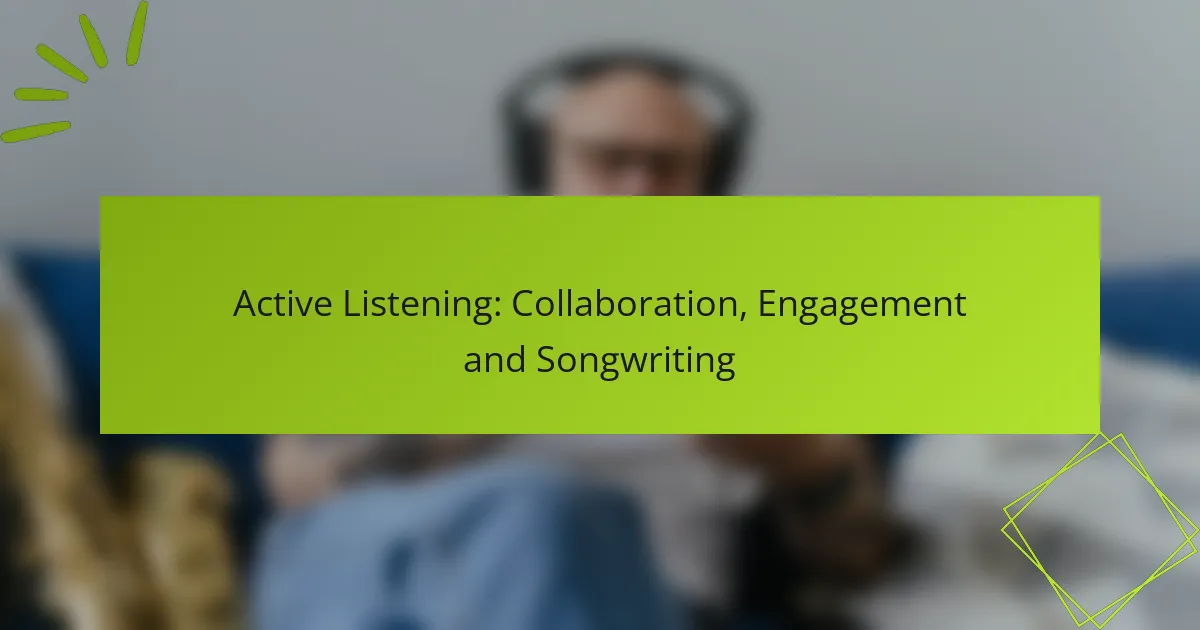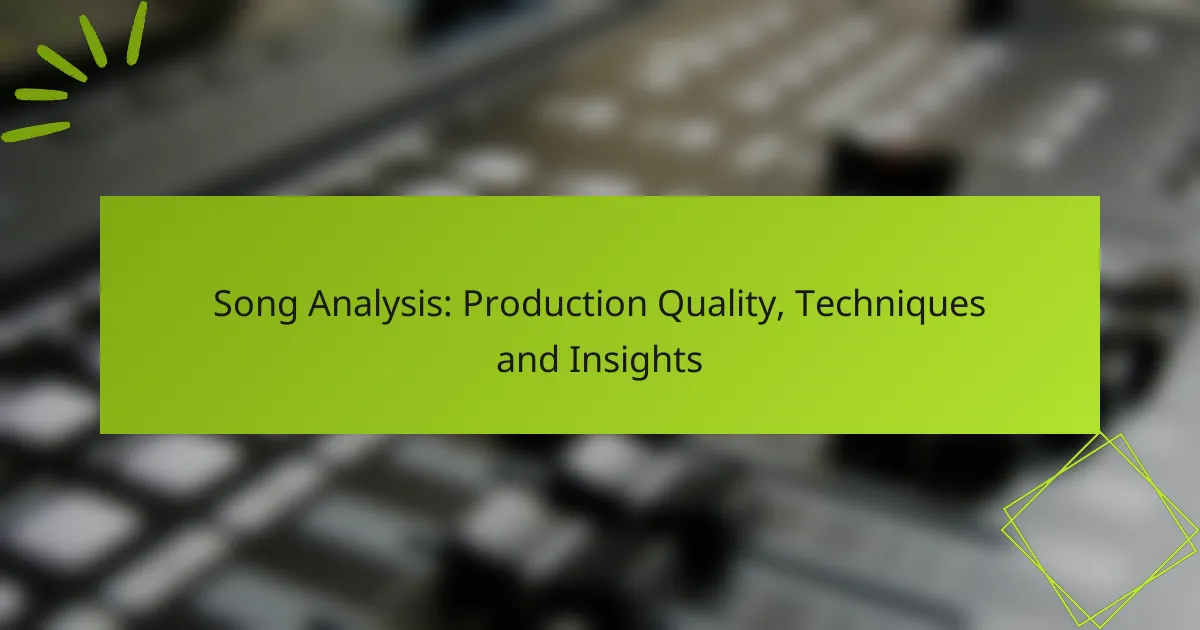Active listening plays a crucial role in enhancing collaboration and engagement in songwriting. By deeply understanding each other’s ideas and emotions, songwriters can create a more cohesive and innovative musical experience. Techniques such as reflective listening and asking clarifying questions foster a productive environment, leading to stronger lyrics and melodies.
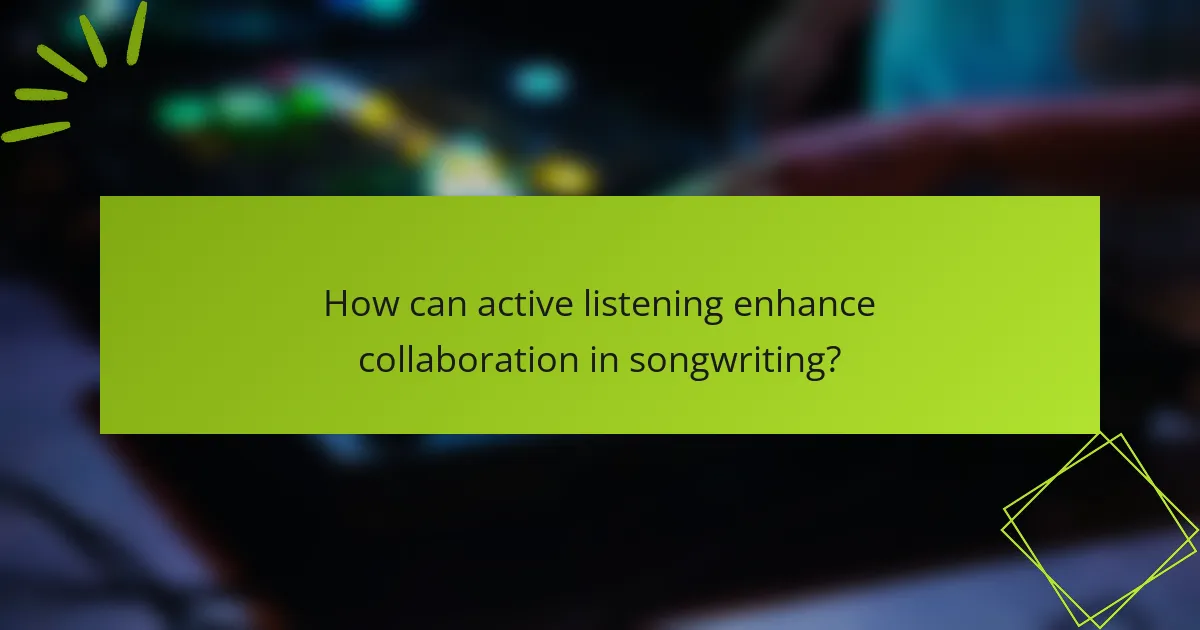
How can active listening enhance collaboration in songwriting?
Active listening significantly improves collaboration in songwriting by fostering a deeper understanding of each collaborator’s ideas and emotions. This practice encourages songwriters to engage fully with one another, leading to more cohesive and innovative musical creations.
Improved communication among songwriters
Active listening promotes clear communication among songwriters by ensuring that everyone feels heard and valued. When songwriters actively listen, they can clarify intentions and ideas, reducing misunderstandings that often hinder the creative process.
For instance, during a songwriting session, one songwriter may express a vision for a chorus. By actively listening, others can ask clarifying questions, ensuring they grasp the concept fully before contributing their thoughts. This back-and-forth can lead to a more refined and unified song structure.
Stronger creative partnerships
Building strong creative partnerships relies heavily on active listening, as it nurtures trust and respect among collaborators. When songwriters feel that their contributions are genuinely acknowledged, they are more likely to share their ideas openly and take creative risks.
For example, a duo working on a song might alternate between presenting ideas and providing feedback. By actively listening to each other, they can build on each other’s strengths, resulting in a richer and more dynamic final product.
Enhanced feedback mechanisms
Active listening creates an environment where constructive feedback can thrive, essential for refining songwriting. When songwriters listen attentively to critiques, they can better understand the perspectives of their collaborators and make informed adjustments to their work.
To implement effective feedback, songwriters should practice summarizing what they heard before responding. This technique not only shows that they are engaged but also clarifies any potential misinterpretations, leading to more productive discussions and improvements in the songwriting process.
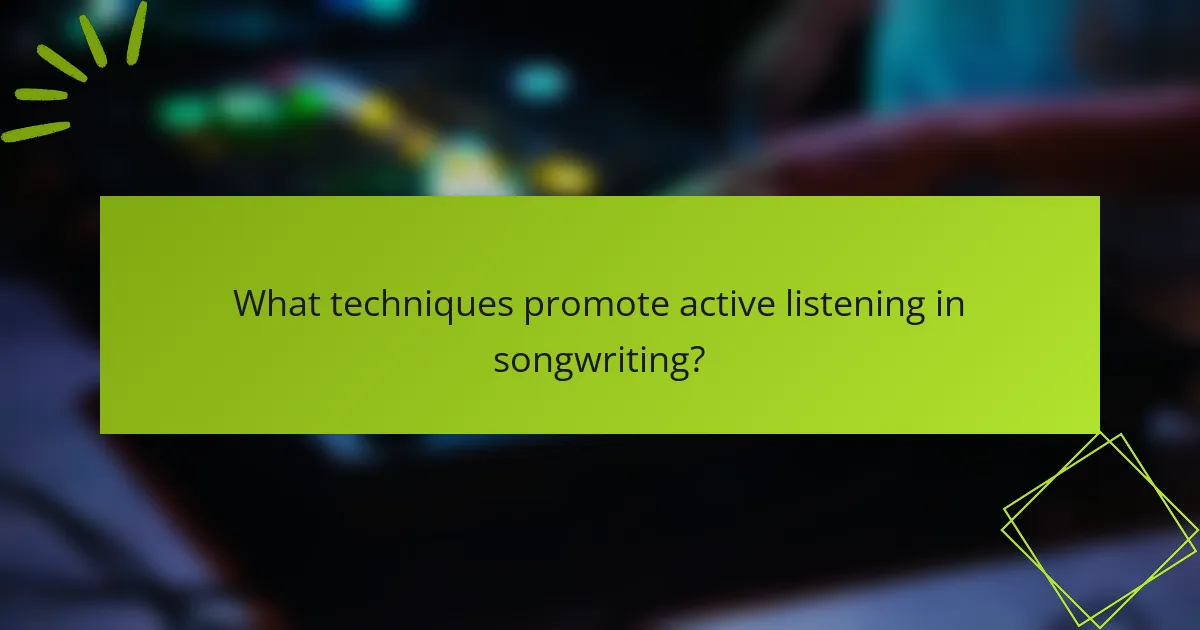
What techniques promote active listening in songwriting?
Active listening in songwriting involves techniques that enhance collaboration and engagement among songwriters. By employing methods such as reflective listening, asking clarifying questions, and paraphrasing ideas, songwriters can create a more productive and harmonious writing environment.
Reflective listening
Reflective listening requires a songwriter to fully concentrate on what others are saying and then mirror those thoughts back. This technique not only shows understanding but also encourages deeper exploration of ideas. For instance, if a collaborator shares a concept, responding with, “What I hear you saying is…” can validate their input and stimulate further discussion.
To practice reflective listening effectively, maintain eye contact and use affirming body language. Avoid interrupting, and instead, wait for the speaker to finish before reflecting back their ideas. This approach fosters trust and openness in the songwriting process.
Asking clarifying questions
Asking clarifying questions helps to ensure that all collaborators are on the same page regarding concepts and intentions. Questions like “Can you elaborate on that idea?” or “What do you mean by that phrase?” can uncover deeper meanings and prevent misunderstandings. This technique is crucial in a creative setting where nuances matter significantly.
When formulating clarifying questions, aim for open-ended inquiries that invite elaboration. Avoid yes-or-no questions, as they may shut down dialogue. This practice not only enhances clarity but also demonstrates genuine interest in the collaborative process.
Paraphrasing ideas
Paraphrasing involves restating what someone else has said in your own words, which confirms understanding and encourages further dialogue. For example, if a collaborator expresses a feeling about a lyric, paraphrasing it as “So, you feel that the lyrics convey a sense of longing?” can affirm their emotions and prompt additional insights.
To effectively paraphrase, focus on the essence of the message rather than the exact wording. This technique can help clarify complex ideas and ensure that all participants feel heard. It’s a valuable tool for maintaining engagement and collaboration in the songwriting process.
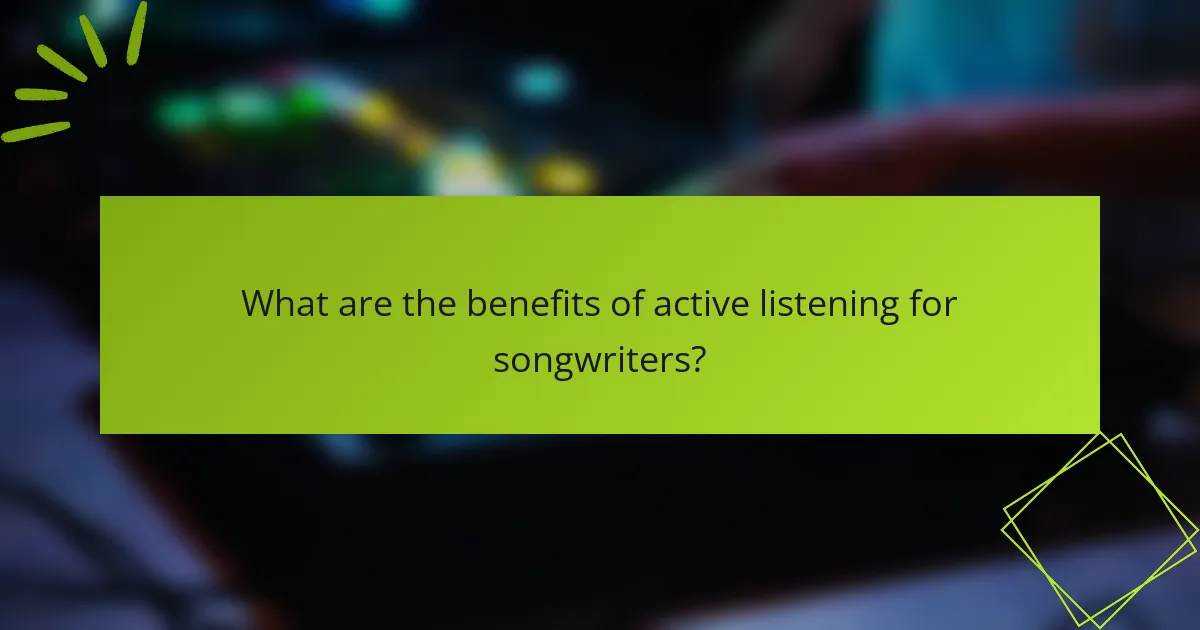
What are the benefits of active listening for songwriters?
Active listening enhances collaboration among songwriters by fostering deeper connections and understanding. This practice leads to more meaningful lyrics and melodies, ultimately resulting in stronger songs.
Increased emotional connection
Active listening allows songwriters to tap into the emotions of their collaborators. By fully engaging with what others express, writers can create lyrics that resonate on a personal level, making the song more relatable to audiences.
For example, when one songwriter shares a personal story, attentive listening can inspire lines that reflect genuine feelings, enhancing the overall emotional depth of the piece.
Greater idea generation
When songwriters actively listen, they open themselves up to a wider range of ideas. This collaborative approach encourages brainstorming and can lead to innovative concepts that might not surface in a more traditional writing environment.
Consider setting up a session where each writer shares a theme or concept, and the group builds on those ideas through active listening. This can result in a diverse array of lyrical and melodic possibilities.
Improved conflict resolution
Active listening plays a crucial role in resolving conflicts that may arise during the songwriting process. By truly hearing each other’s perspectives, songwriters can address disagreements constructively rather than letting them escalate.
To navigate conflicts, encourage open dialogue where each person shares their viewpoint without interruption. This not only helps in finding common ground but also strengthens the collaborative bond among songwriters.
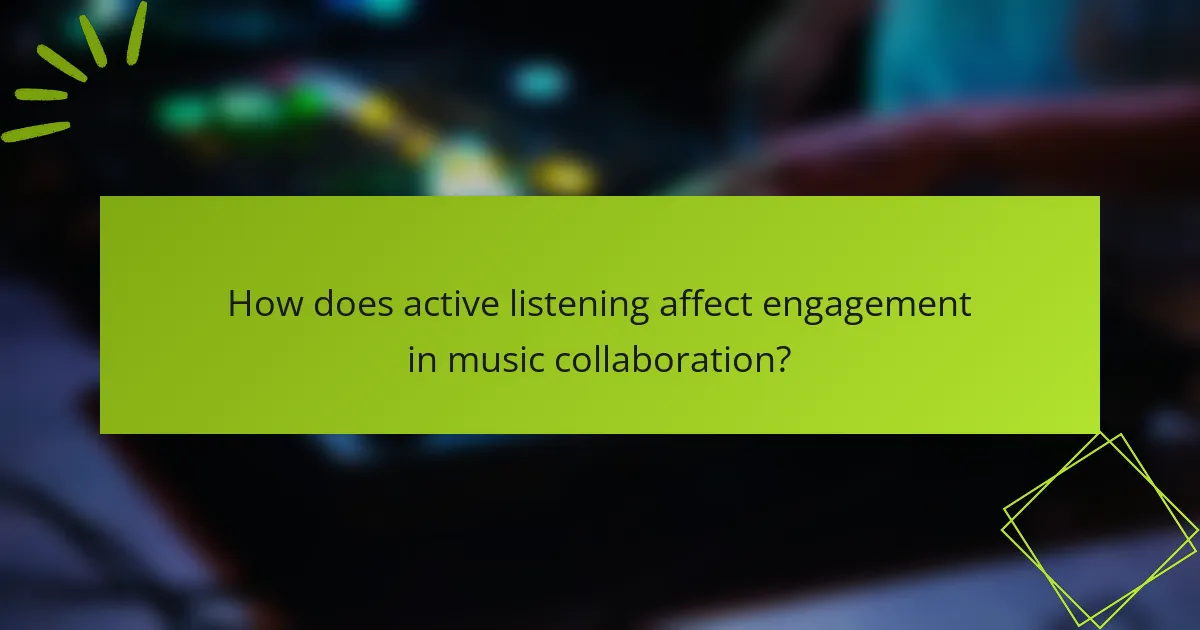
How does active listening affect engagement in music collaboration?
Active listening significantly enhances engagement in music collaboration by fostering deeper connections among participants. It encourages musicians to fully understand each other’s ideas and emotions, leading to more cohesive and innovative outcomes.
Fosters a supportive environment
Active listening creates a safe space where collaborators feel valued and understood. When musicians actively listen, they validate each other’s contributions, which builds trust and encourages open communication.
To foster this supportive environment, consider implementing regular feedback sessions where each member shares their thoughts without interruption. This practice can enhance mutual respect and strengthen relationships within the group.
Encourages diverse perspectives
By engaging in active listening, collaborators can appreciate a variety of viewpoints, which enriches the creative process. This diversity often leads to unique musical ideas and solutions that may not emerge in a less inclusive setting.
To effectively encourage diverse perspectives, invite input from all members during brainstorming sessions. Use techniques like round-robin sharing to ensure everyone has a chance to voice their thoughts, thus maximizing the creative potential of the group.
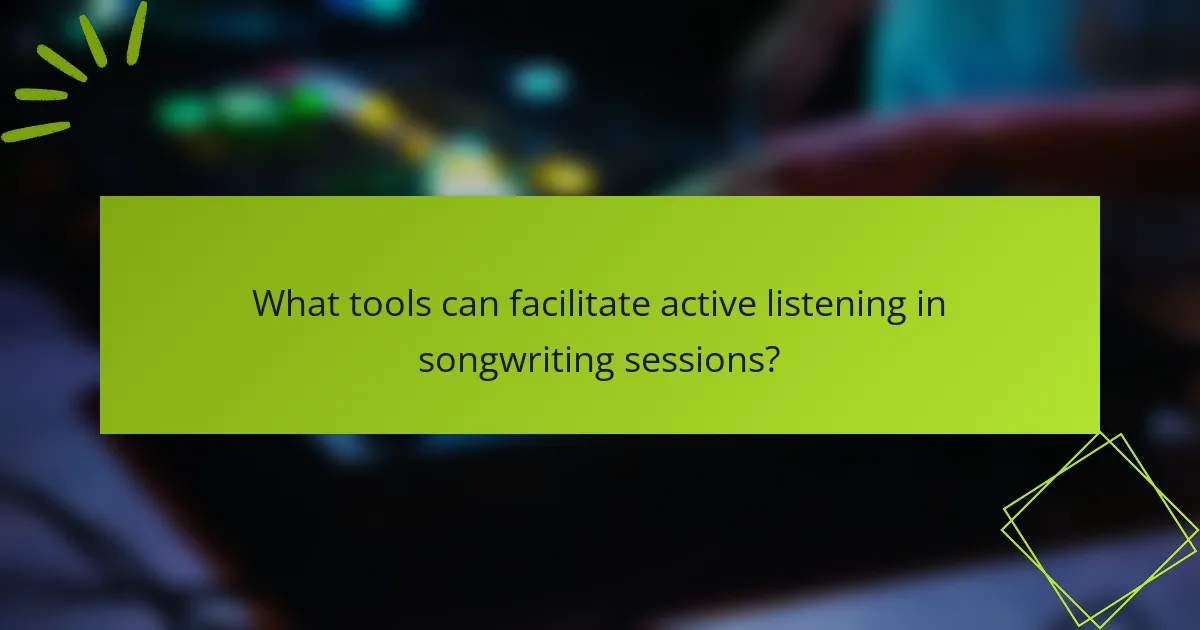
What tools can facilitate active listening in songwriting sessions?
Active listening in songwriting sessions can be enhanced through various digital tools that promote collaboration and engagement. These tools help songwriters share ideas, provide feedback, and create music together, regardless of their physical location.
Collaboration platforms like Soundtrap
Soundtrap is a cloud-based platform that allows multiple users to collaborate on music projects in real-time. Users can record, edit, and mix tracks while communicating through integrated chat features, which fosters an environment of active listening and immediate feedback.
When using Soundtrap, consider setting clear roles for each collaborator to streamline the creative process. For example, one person might focus on lyrics while another handles instrumentation. This division can help maintain focus and enhance the quality of contributions.
Virtual meeting tools like Zoom
Zoom is a widely used virtual meeting tool that can facilitate active listening during songwriting sessions by allowing participants to discuss ideas face-to-face, even when miles apart. Screen sharing features enable users to showcase their work, making it easier to provide constructive feedback in real-time.
To maximize engagement on Zoom, establish ground rules for discussions, such as allowing each person to speak without interruption. This practice ensures that everyone feels heard and valued, which is essential for productive collaboration in songwriting.
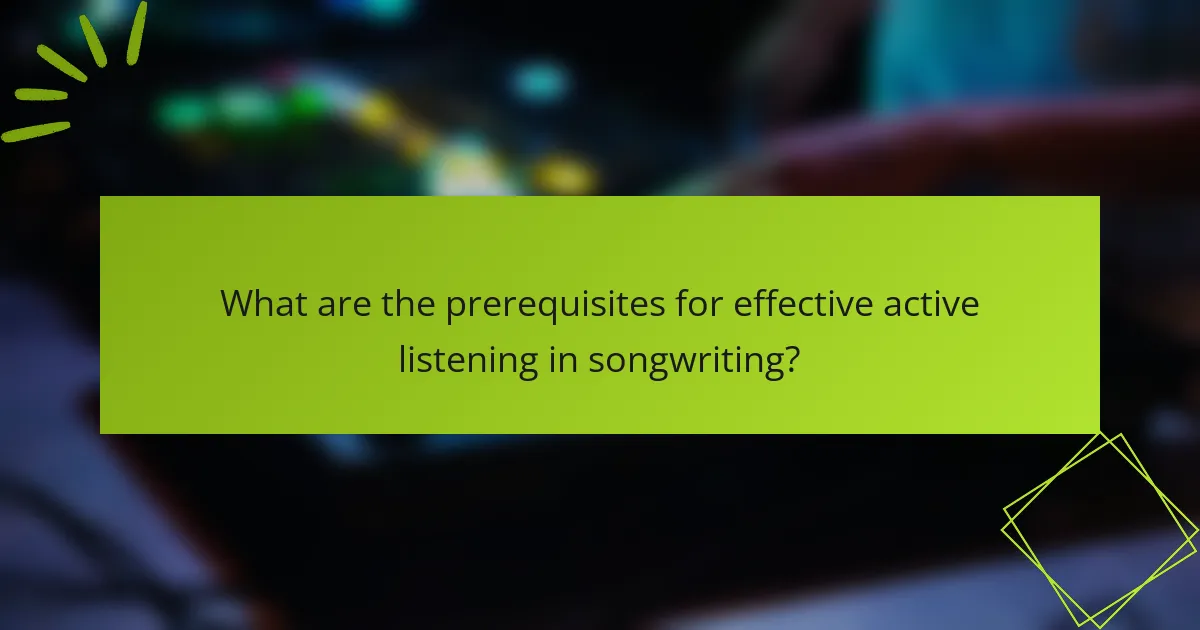
What are the prerequisites for effective active listening in songwriting?
Effective active listening in songwriting requires a combination of open-mindedness, empathy, and focus. These elements help songwriters fully engage with their collaborators, fostering a creative environment where ideas can flourish.
Open-mindedness
Open-mindedness is crucial for active listening in songwriting as it allows individuals to consider diverse perspectives and ideas. By setting aside personal biases and preconceptions, songwriters can better appreciate the contributions of their collaborators.
To cultivate open-mindedness, approach discussions with curiosity and a willingness to explore new concepts. This can involve asking questions and seeking clarification, which encourages a richer dialogue and deeper understanding of the creative process.
A practical tip is to practice active questioning during songwriting sessions. Instead of immediately dismissing an idea, ask, “What inspired this?” or “How does this fit into our vision?” This approach can lead to unexpected breakthroughs and enhance the collaborative experience.
